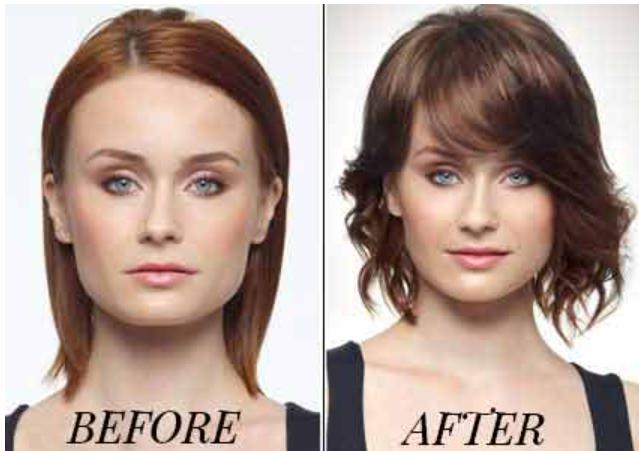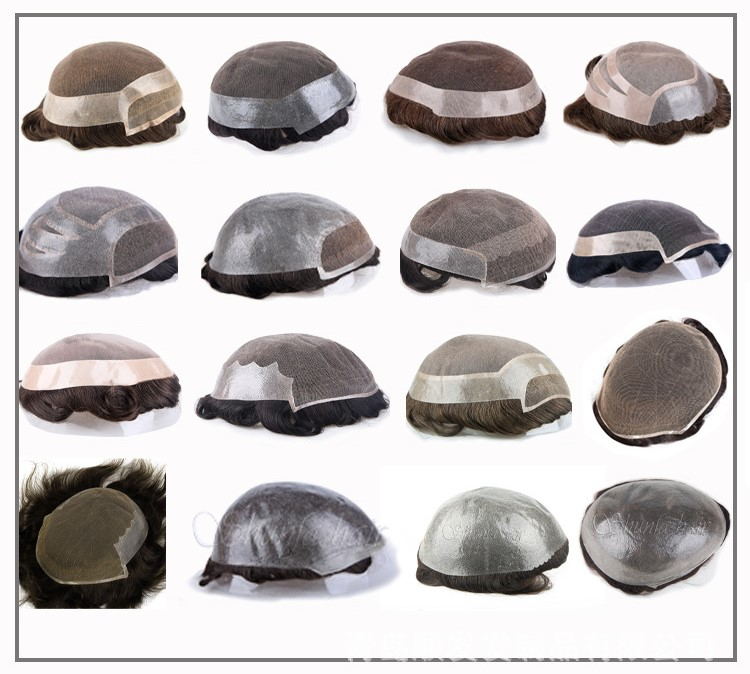Hair pieces for women come in many different varieties—and our collection of women’s hairpieces has all of them! Whether you’re looking for clip on hair pieces, extensions, hair wraps, or hair toppers for thinning hair, you’ll find your ideal match here.
What is A Hair Topper?

Designed to conceal hair loss at various stages and different areas of the scalp, hair toppers come in many shapes and sizes. Some offer more coverage on the top, while others aim to cover the sides or back of the head. Some are even specifically designed for the sole purpose of adding volume to thin or fine hair.
One thing to keep in mind when shopping for a wiglet is that there is no one size fits all solution. Each hairpiece is meticulously designed to offer coverage where you need it and to blend in with your existing hair.
With toppers or wiglets, you are able to uniquely address your partial hair loss needs. Multiple hairpieces can be worn to cover more than one area, making them a great alternative to a full wig for women with thinning hair. When choosing a hair topper or wiglet, you will want to note the base style and size, the hair length, hair type and color. This will help determine which topper style is right for you.
Hair Toppers: Before and After
Toppers can add body to your hair as well as conceal patches of hair loss. Here are a few “before” and “after” photos. As you can see, hair toppers can significantly change your look as well as conceal thinning hair or balding patches seamlessly.
Who Needs a Hair Topper?
Anyone with hair loss who wishes to cover up thinning areas or baldness on the scalp may desire a hair topper. This type of hair loss can occur as a result of aging, alopecia, certain medications (like chemo), stress, trichotillomania and many other conditions.
If you feel that your hair is lacking volume, a topper can not only help disguise areas of hair loss, but add the look of fullness to your existing hair as well. Not everyone who wears a topper has hair loss. Some women wear toppers to balance out lengthy extensions by adding more hair to the top of the head with a hairpiece.
How To Select a Hair Topper
STEP 1: DETERMINE THE COVERAGE NEEDED
It is easiest to begin shopping for a hair topper or wiglet by determining the type of hair loss that you are experiencing. The stages of hair loss can be classified by the amount of hair that you have lost.
Beginning Stage Hair Loss
Hair loss begins in a diffused pattern at the top of the head resulting in minimal loss. Most women with this stage of hair loss will need a topper with a smaller base size or one with an interable base.
Progressive Stage Hair Loss
This is the stage of hair loss where the scalp becomes noticeable through sparse areas of hair. A medium to large base is typically needed.
Advanced Stage Hair Loss
Hair loss at this stage is typically very noticeable and completely bald areas of scalp are visible. The largest of base sizes will work to completely conceal hair loss. Some women with advanced stage hair loss may want to consider shopping for a full wig.
Measure the Width and Length Hair Loss
With a soft measuring tape, record the measurements of the widest points from front to back and side to side across the area where you are experiencing hair loss.
Record the measurements, adding one inch to each measurement to allow for a half an inch of hair on each side or end of the base for a clip to attach into your existing hair.
If your measurements are larger than what you see available in our topper selection, try having a friend or family member take your measurements to double check your accuracy. If you are still finding your area of hair loss to be larger than the topper bases offered, you may consider shopping for a full wig.
Determine the Area of Coverage
Now that you’ve identified the overall size, your next consideration is the coverage area. In this aspect, you’ll find several options available. Each coverage type is accompanied by a chart of styles, complete with detailed measurements. This enables you to easily match your coverage needs with the appropriate topper style.
STEP 2: CHOOSE A BASE TYPE
Now that you know your measurements, take note of where your hair loss is located. This will help in determining the type of base that you choose. For example, if your hair is thinning mainly at the part, you may need a base that is long and skinny with a monofilament construction. But if your hair is thinning at the crown, you may need a wider base and be happy with a classic style construction. There are two basic base types:
Monofilament Base
This base is formed by attaching each individual hair to a soft mesh material. Because each hair is hand tied to the base, it gives the appearance of real hair growing from the scalp.
Classic Base
This type of base features rows or wefts of hair. Often, your own hair can be pulled in between the wefts to integrate your own hair with the hairpiece.
Lace Front: Hair toppers with a lace front offer the most realistic looking front hairline. With lace front toppers, the front of the cap features hair that is individually tied to a fine piece of lace. This makes it look as if the hair along the front hairline is growing right from the scalp. For styles where the hairline is exposed in front, a lace front option is a great choice. If your topper has bangs or if you are wearing your topper further back on the head, the lace front option is not needed.
STEP 3: SELECT HAIR TYPE, LENGTH & COLOR
Selecting Your Hair Type:
Just like wigs, hair toppers come in synthetic, human hair and heat friendly synthetic hair options. Because a topper is meant to blend in with your existing hair, many women prefer heat friendly synthetic or human hair toppers. These types of hair allow you to create texture with heated styling tools that closely resembles your own hair. Synthetic toppers are a great option as well. Synthetic toppers come in straight, wavy and curly textures to help you find just the right one to blend with your own hair. They are also very easy to maintain and offer a high-quality look at an affordable price point. We recommend learning about the pros and cons of the different hair types here: Human Hair vs. Synthetic Hair to ensure that you are selecting the best hair type for your needs.
Selecting the Length of Your Topper:
The length of the topper that you will want to choose will depend on the look that you are trying to achieve. Women with short hairstyles often desire wiglets that match the length of their style from root to end, while women with longer hairstyles can choose toppers that range in length from short to long depending on whether or not their hair is layered. A gorgeous topper can be a great way to add the look of layering to your existing style. You can choose to wear a topper with strands shorter than the length of your existing hair and have your stylist cut your hair to look like the topper is layered into the rest of your hair.
Typically, toppers come in short length, 8″, 12″, 14″, 16″, and 18″ lengths, depending on the designer. The price increases as the length increases. Here is a guideline:
Short Lengths: Go with most short hairstyles
8″: Typically worn with chin length styles
12″: Between chin and shoulder length
14″: Shoulder length to mid length
16″: Long lengths below the shoulders
18″: Very long lengths
Selecting the Color for Your Topper:
Achieving a close match between your hair topper and your natural hair color is essential. However, please keep in mind that an exact match may not always be attainable for every shade. To assist you in this process, we encourage you to take advantage of our complimentary wig consultations led by our expert stylist. She can provide guidance through photos or hair swatches to help you find the right color. For the utmost precision in color matching, submitting a hair swatch to our stylist is the best option. Her discerning eye can detect even the subtlest color differentiations.
When it comes to color selection, there are two main approaches. The first is to match the color of your topper to your own hair. The second involves selecting a topper shade that closely resembles your hair and then having your natural hair professionally dyed to match the topper. This approach can provide an exceptionally realistic result.
In cases where an exact match isn’t attainable, selecting a slightly lighter shade can give the appearance of highlights, which many find pleasing. If you find yourself between shades, we recommend leaning towards a lighter shade rather than darker one, particularly considering its placement in the upper layers of your hair. For more insights on color selection and how to set up a free consultation, see our Color Guide.
How to Wear Your Hair Topper
Once you have found your perfect hairpiece, you’re ready to clip it in and go!
PRO TIP: Lightly tease your hair in the areas where the topper clips will attach to get a more secure hold.
Prepare & Position
Open all clips on the underside of the topper. Place the front edge of the topper approximately 1-2 inches from the front of your hairline, positioning it over the area of hair loss, and secure the front clip.
Secure & Style
Place light pressure over the top of the hairpiece and run your fingers over the length of the base to secure the back clip(s). Keep the base pulled tight across the top as you secure any side clips.Style and blend hair as desired.
Other Types of Hairpieces
Clip-In Bangs:
These hairpieces offer coverage at the front of the hairline that can cover any unevenness in that area. They are also a great option for women who want to try wearing bangs without the commitment. Try modern blunt cut bangs or classic side swept fringe to change up your look.
Hair Extensions:
Extensions do not offer coverage, but rather work to add length or fullness by attaching into your existing hair without a base. Some extensions clip in as individual strips of hair with one clip to attach at the root of your hair, while others offer several clips across a strip of hair that covers a wider width side to side.
Volumizers:
This type of hairpiece does not cover areas of hair loss. Volumizers feature integrable bases that allow you to pull your hair through the wafting and blend the hairpiece seamlessly with your own hair to create fullness in a targeted area. Look for the hairpieces labeled “Volumizers” on our Hair Topper page.







